The human factor
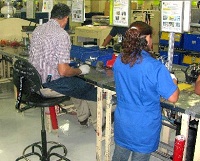 |
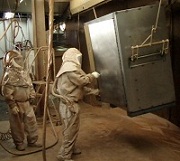 |
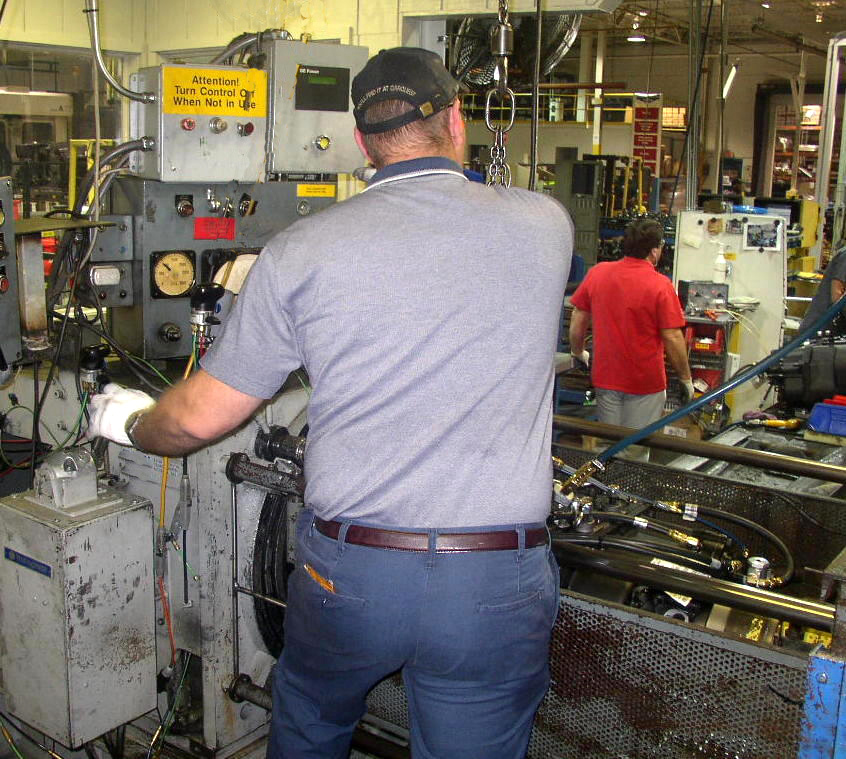 |
| Small work cell, workbenches | Capital intensive, overhead conveyor | Production area without “line” per se |
The human interface with equipment is a critical factor in the design and operation of efficient production. Although the human factor is sometimes poorly understood and even overlooked, there has in fact been remarkable improvement in production operations that take full advantage of employee capabilities, including employee well-being as a goal in itself.
These how-to guides and the accompanying knowledgebase of best practices provides an effort to consolidate practical information on optimizing employee capabilities in the production process. Although the starting point is human-friendly design, many of the points make good production sense whether or not humans are involved.
Note on terminology: The term production “line” is used here for the sake of simplicity, but the topics affect operations that may not be laid out in a line per se. Often the only difference between a production “line” and a more generic “production area” is the material handling system, typically single piece flow vs. handling material in batches. See below.
Evolution of the assembly line
Considerable improvements for human factors have been implemented in the classic assembly line, with solid benefits for efficiency, quality, and employee well-being.
High tech example: auto assembly
The auto assembly line provides a good high tech example of this evolution:
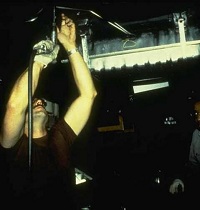 |
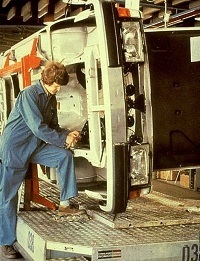 |
 |
| Traditional auto underbody assembly — working in a pit under the line, arms continuously overhead | Volvo (1970, Kalmar, Sweden) — basic adjustment of height and orientation | Volkswagen (2002, Dresden, Germany)— highly variable height and orientation |
The traditional auto assembly line constituted a breakthrough in production, but placed the cars uniformly in the same orientation and height, which consequently caused employees to work in awkward positions that led to defects, slowed production, and musculoskeletal injuries.
In 1970, Volvo pioneered the concept of using large powered fixtures on automatic guided carriers to raise and lower the cars as needed and to flip the vehicles on their sides for underbody work. The ability to change height and orientation provided for less strain on employees, and more efficient production, especially less rework. The biggest payback was the lowered cost of quality. The automatic guided carriers allowed the cars to follow a cord on the floor, which enabled the cars to be stationary during assembly and permitted the direction of the line to be changed easily.
The new Volkswagen plant in Dresden, Germany, opened in 2002, suspends the cars from an overhead track, using a telescoping vertical post for height adjustment and a rotating fixture to orient the car in different angles depending on the task being performed.
Low tech example: ham boning
For an unglamorous and low-cost illustration, the meatpacking industry provides an example:
 |
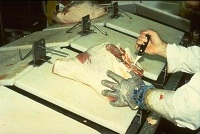 |
| Traditional ham boning line — awkward and slow | A slanted ham boning line — better visibility, easier cuts |
The traditional ham boning line uses a horizontal belt conveyor, which puts the employee in an awkward position that makes it more difficult to do the work. Slanting the cutting boards (still on a moving conveyor) provides a better orientation. Employees can see better and the cuts can be made more easily.
The line that provides the highest yields in the industry (not shown for proprietary reasons) changes heights and slant angles at each step of the line to optimize production. The hams move up, down, and around somewhat like being on a roller coaster.
Modern production strategies
Lean
Recent decades have witnesses the introduction of an impressive array of techniques to streamline and enhance production. These methods are usually grouped together under the heading of lean production and include subjects such as:
- JIT — Delivery of materials just-in-time to be used
- Six sigma — Reduction of defects (and often changes in the organizational culture to achieve that reduction)
- SMED — Quick changeover of presses, machines, and entire work areas
- 5S (or 6S) — efficient organization of the work area
- Supply change management
Many of these techniques inherently benefit employees and their ability to do their jobs well, such as developing a well-organized work area. Other techniques can be easily supplemented with a few concepts to help insure the jobs improve from the employee’s perspective.
Production ergonomics
Improving the human-equipment interface is typically implicit in lean considerations, although often not explicitly labeled as ergonomics. In this website, that relationship is made explicit. Clearly, the field of production ergonomics is intertwined with that of lean and is the basis for these “how-to” guides and the associated knowledgebases.
The principles of ergonomics have been particularly effective in reducing the risk of musculoskeletal disorders, such as back injuries and shoulder problems. For this reason, the field is often erroneously perceived as synonymous with these injuries. However, as described in the foundations of production ergonomics the field is much broader and has historically had direct impact on better design of tools, equipment, and tasks with the goal of symultaneously improving productivity, quality, and employee well-being.
Components of production
This website provides guidance on setting up production operations ranging from a single workstation to a full assembly line, including hand tools and maintenance. Setting up equipment on a production line basically amounts to combining a number of basic elements, each of which is described in a separate “how-to” guide. You should review each guide for key concepts and as a lead-in to the related knowledgebase with its specific topics and techniques.
The individual workstation
A workstation is a point of interface between employees and the product or related equipment. A workstation can be either:
- Stationary at a single machine or workbench, or
- Flexible on a moving line.
In either case, the starting point for setting up a production line is understanding the optimal interface for the product relative to the person doing the work. Defining the optimal interface should be undertaken for each step of the production process, which in turn establishes the design objectives for much of the equipment needed for the line. Employees need easy access to the product, they need to see, and they need to keep in a productive working position. They need to access tools and materials as readily as possible. Thus, this critical step should be taken before even thinking about the equipment.
See How to design a workstation and the list of specific issues and options in the Workstation best practices knowledgebase.
Material handling systems
Materials need to be moved to and from each workstation, whether separate workstations or integrated on a moving line:
- Separate machines or workbenches connected by delivery of batches of materials, such as by forklift trucks or manual carrying of totes.
- A single line, with workstations connected by single piece flow, such as with a conveyor or sliding surface for the product.
The basics of material handling are generally well known. However, it is difficult for personnel in a given workplace to be familiar with the array of methods that are used elsewhere.
Material handling is best considered as a whole system throughout a facility, rather than addressing a single location. By following the complete flow and taking into account the whole chain of transfers, it is easier to recognize wasted steps and incompatible handling methods.
The concepts of lean generally place considerable stress on improved material handling. Often these techniques inherently benefit the employees’ ability to do their jobs well, but the techniques can be optimized by deliberate attention to human factors.
Typically in most work places material handling is highly mechanized, but with gaps in predictable locations, such as the final step of delivering items to the point of use. At this step, materials are often handled manually, often with a need to lift items to the correct height and orient properly for use. The result is a loss of efficiency and high risk for back injuries and other disorders.
See How to improve manual material handling and the related Material handling knowledgebase.
The machine-operator interface
From the perspective of this website, a manually operated machine is a specific type of workstation. It requires special attention because the size and function of machines can create barriers for attaining the optimal human interface.
Furthermore, machines typically have unique points of operation that materials must be placed into and removed from, often by hand. Consequently, it can be difficult to fully integrate machines into the production line and may require special efforts for material handling.
Smaller machines are easier to integrate fully into a moving line for efficient production, especially with insights and guidance by the best practices available on this site. Larger machines are more difficult, but improvements are often possible.
Changeovers of machines also involve special issues, in part because the components that need to be switched out are heavy and, in contrast to completely manual work where the human provides more flexibility, the machine components must be set up precisely within the mechanisms of the rest of the machine.
The section How to improve the machine-operator interface and the separate Machine-operator best practices knowledgebase address the special issues involving machines.
Hand tools
Hand tools are used in every operation, but not always the best ones for the task at hand. The phrase “right tool for the right job” is an excellent one, but it is not always clear how to determine what is the right tool.
The sections here related to hand tools provide guidance and examples on the proper selection and use of hand tools. Furthermore, the information suggests ways to modify existing tools and design new ones, whether simple home made devices or commercially available ones.
Related issues are supports and holders for tools along with their storage at the point of use.
See How to improve hand tool use and the related Hand tool best practices knowledgebase
Maintenance
An often-neglected issue when designing machines or setting up production areas is giving sufficient consideration for maintenance, whether repairs, cleaning, or tune ups. Clearance and access should ideally be provided, along with equipment features that facilitate the ease of maintenance.
See the guidance in How to improve the ease of maintenance along with specific issues and options in the Ease-of-maintenance best practices knowledgebase
Extra [in development]
Even the advent of high technology such as robotics doesn’t eliminate the human interface completely, rather it simply changes the nature of interface. For example, a robot eliminates direct contact between a manual assembler and the product, but it creates new interfaces with the robot for operation and maintenance. In both cases, the human-equipment interface can be an issue.
A production line consists of a series of workstations that are connected one way or another by material handling systems. In this context, production can be arranged either as:
Combining the separate elements
By considering the information on each of the above factors, it should be possible to gain ideas for putting together a system that fits your requirements. The following are comments on several common issues that arise when combining the separate elements into a single production line.
– – –
Other issues
Additionally, there are multiple other factors that must be addressed, such as staffing, training, division of labor, flow, balance, and maintenance. However, the four factors above address the physical equipment that is the focus of of this website.
